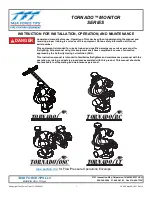
Section 1: Assembly & Set-up
RC(M)4715 & RCG(M)4715 Rotary Cutters 334-113M
6/3/20
13
Tractor Requirements
Tractor horsepower should be within the range noted
below. Tractors outside the horsepower range must not
be used.
Horsepower Rating . . . . . . .55-250 hp (41-186.4 kW)
Hitch Type (See Drawbar Set-up) . . . . . . . . . Drawbar
Rear Power Take-off Speed:
RC4715. . . . . . . . . . . . . . . . . . . . . . . . . . . .540 rpm
RCG4715 . . . . . . . . . . . . . . . . . . . . . . . . . .540 rpm
RCM4715 . . . . . . . . . . . . . . . . . . . . . . . . . 1000 rpm
RCGM4715 . . . . . . . . . . . . . . . . . . . . . . . . 1000 rpm
Hydraulic Outlets (See Hydraulic Set-up)
Factory Standard. . . . . . . . . . . . . . . 2 duplex outlets
Drawbar Set-up
Refer to Figure 1-1:
WARNING
!
To prevent serious injury or death:
•
Do not use a tractor that is too small or too large. Small
tractors can be pushed around and flipped over. Large
tractors can damage the attached implement.
•
Do not use a power take-off adapter. The adapter will
increase strain on the tractor’s power take-off shaft causing
possible damage to shaft and driveline. It will also defeat
the purpose of the tractor’s power take-off shield.
•
Power take-off damage may occur if distances “A” and
“B” are not properly maintained.
Maintain proper distance, dimension “A”, between center
of drawbar hitch pin hole and end of tractor power take-off
shaft.
540 rpm & 1 3/8", 1000 rpm power take-off speed:
“A” . . . . . . . . . . . . . . . . . . . . . . . . . . . . . . . . . 14"- 16"
“B” . . . . . . . . . . . . . . . . . . . . . . . . . . . . . . . . . . 8"- 10"
“C” . . . . . . . . . . . . . . . . . . . . . . . . . . . . . . . . . 18"- 22"
1 3/4", 1000 rpm power take-off speed:
“A” . . . . . . . . . . . . . . . . . . . . . . . . . . . . . . . . . 18"- 20"
“B” . . . . . . . . . . . . . . . . . . . . . . . . . . . . . . . . . 10"- 12"
“C” . . . . . . . . . . . . . . . . . . . . . . . . . . . . . . . . . 18"- 22"
Power Take-off Drawbar Distance
Figure 1-1
22273
A
Power Take-Off Shaft
Drawbar
B
Ground Level
C
Hydraulic Outlets
Depending on purchased fold option, two to three duplex
outlets are required. Two outlets are needed when
choosing a fold option where the wings fold
simultaneously. Three outlets are needed when choosing
a fold option where the wings fold independently.
Land Pride highly recommends connecting the wing fold
hose(s) to a duplex outlet with float capabilities and use
the float when in field operation.
Accessory available to convert from two duplexes to one
duplex.
Before You Start
Be sure to read and fully understand this Operator’s
Manual. An understanding of how the Rotary Cutter works
will aid in the assembly and setup of your machine.
It is best to go through the
page before assembling the Rotary Cutter. To speed up
your assembly task and make the job safer, have all
needed parts and equipment readily at hand.
Torque Requirements
See
“Torque Values Chart for Common Bolt Sizes”
page 65 to determine correct torque values when
tightening hardware. View bottom of chart for “
Additional
Torque Values”
for exceptions to common torque values.
Assembly Checklist
Check
Ref.
Have a hoist, fork lift, or loader with properly sized chains and
safety stands capable of lifting and supporting the equipment on
hand.
Have a minimum of two people available during assembly.
Make sure all major components and loose parts
are shipped with the machine.
Operator’s
Manual
Double check to make sure all parts, fasteners,
and pins are installed in the correct location.
Refer to the Parts Manual if unsure. By double
checking, you will lessen the chance of using a
bolt incorrectly that may be needed later.
NOTE:
All assembled hardware from the factory
has been installed in the correct location.
Remember location of a part or fastener if
removed. Keep parts separated.
Operator’s
Manual
334-113M
Parts Manual
334-113P
Make sure working parts move freely, bolts are
tight & cotter pins are spread.
Operator’s
Manual
Make sure safety guards are installed and in
good working order.
Make sure all safety labels are correctly located
and legible. Replace if damaged.
Make sure lights are functioning properly.
Make sure all grease fittings are in place and
lubricated.
Make sure all pneumatic tires are properly
inflated and all wheel bolts and axle nuts are
tightened to the specific torque.
Section 1: Assembly & Set-up
















































